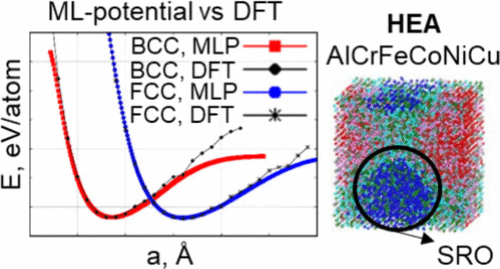The paper was published in J. Phys. Chem. C.
In recent years, high-entropy alloys (HEAs) have emerged as a significant area of interest within the materials science community. These materials, characterized by their unique properties and compositional complexity, hold promise for various industrial applications, particularly in fields requiring high-performance materials. This research aims to investigate the mechanical properties, phase transformations, and stability of HEAs composed of various combinations of Al, Cr, Fe, Co, Ni, and Cu, with a specific focus on understanding how the concentrations of these elements influence the structural behavior and material characteristics across different crystalline phases, including face-centered cubic, body-centered cubic, and polycrystalline configurations.
High-entropy alloys typically consist of five or more principal elements in near-equimolar proportions, which contributes to their unique microstructural characteristics. This compositional diversity is believed to lead to enhanced mechanical properties, such as increased strength, improved ductility, and greater resistance to corrosion and wear. However, the underlying mechanisms responsible for these enhancements remain inadequately understood. As such, there is a pressing need for comprehensive investigations that explore the effects of elemental interactions, phase stability, and mechanical behavior under various conditions.

To achieve these objectives, the study will utilize advanced computational modeling techniques, particularly those involving machine learning. By employing machine learning interatomic potentials, we seek to create predictive models that can accurately simulate atomic interactions in high-entropy alloys. This approach enables a more extensive exploration of the compositional space, facilitating the identification of optimal alloy compositions that exhibit desirable mechanical characteristics. We predicted key material properties essential for a thorough understanding of HEA behavior under different loading and environmental conditions.
Moreover, we delved into the phase transformations that occur within HEAs when subjected to varying temperatures and elemental concentrations. Understanding these transformations is crucial for tailoring the mechanical properties of the alloys to meet specific application requirements. It is essential to analyze how different elements, particularly Co, Ni, and Cu, impact the stability of various phases and the overall mechanical performance of the alloy. For instance, variations in the concentrations of these elements can lead to changes in the phase diagrams of HEAs, which in turn influence their mechanical behavior and thermal stability.
We hope that our results could inform the design and synthesis of advanced materials that not only meet the demands of specific engineering applications but also exhibit improved performance characteristics compared to conventional alloys.
